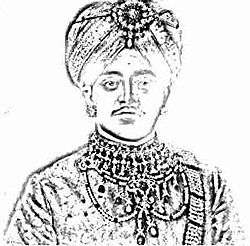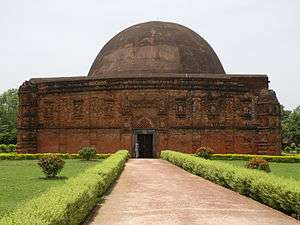Ganesha dynasty
The Ganesha dynasty began with Raja Ganesha in 1414, from the Bengal region of the Indian subcontinent. After Raja Ganesha seized control over Bengal, he faced an imminent threat of invasion. Ganesha appealed to a powerful Muslim holy man named Qutb al Alam to stop the threat. The saint agreed on the condition that Raja Ganesha's son, Jadu, would convert to Islam and rule in his place. Raja Ganesha agreed and Jadu started ruling Bengal as Jalaluddin Muhammad Shah in 1415.
Ganesha dynasty | |||||||||
|---|---|---|---|---|---|---|---|---|---|
| 1416 CE–1436 CE | |||||||||
| Capital | Gaur, West Bengal (present day West Bengal, India) | ||||||||
| Religion | Hinduism later Islam | ||||||||
| Government | Monarchy | ||||||||
• 1414–1415 and 1416–1418 (Second Phase) | Raja Ganesha | ||||||||
• 1415–1416 and 1418–1433 (Second Phase) | Jalaluddin Muhammad Shah | ||||||||
• 1433–1435 | Shamsuddin Ahmad Shah | ||||||||
| History | |||||||||
• Established | 1416 CE | ||||||||
• Disestablished | 1436 CE | ||||||||
| |||||||||
Qutb al Alam died in 1416 and Raja Ganesha was emboldened to depose his son and return to the throne as Danujamarddana Deva. Jalaluddin was reconverted to Hinduism by the Golden Cow ritual. After the death of his father, Jalaluddin once again converted to Islam and started ruling again.[1] Jalaluddin's son, Shamsuddin Ahmad Shah ruled for only 3 years due to chaos and anarchy. The dynasty is known for its liberal policies as well as its focus on justice and charity.
 A sketch of Raja Ganesha, the 1st ruler of the Ganesha dynasty, on the cover of a late 19th-century Bengali work, Raja Ganesh.
A sketch of Raja Ganesha, the 1st ruler of the Ganesha dynasty, on the cover of a late 19th-century Bengali work, Raja Ganesh. Mausoleum of Jalaluddin Muhammad Shah, the 2nd ruler of the Ganesha dynasty, in Gaur, West Bengal, India.
Mausoleum of Jalaluddin Muhammad Shah, the 2nd ruler of the Ganesha dynasty, in Gaur, West Bengal, India..jpg)
References
- Biographical encyclopedia of Sufis By N. Hanif, pg.320